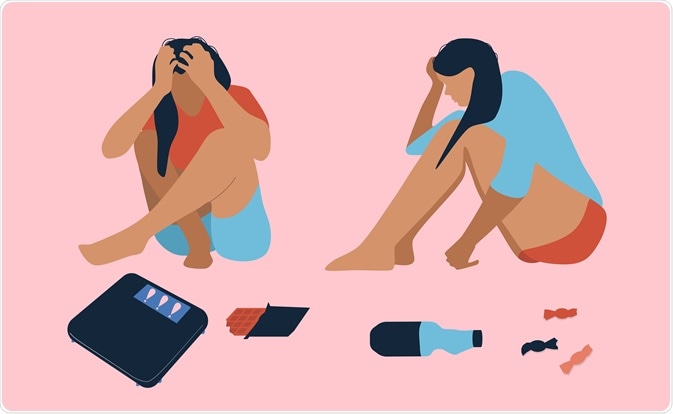Bulimia nervosa is an eating disorder that is characterized by recurrent episodes of binge eating followed by extreme attempts to purge the extra calories. It is important that a diagnosis of the condition is made as early as possible to allow the patient to get adequate treatment and support to avoid complications and begin to recover.
 Image Credit: Dari-designPie / Shutterstock.com
Image Credit: Dari-designPie / Shutterstock.com
DSM-5 diagnostic criteria
The Diagnostic and Statistical Manual of Mental Disorders (DSM-5) published by the America Psychiatric Association outlines the following diagnostic criteria for bulimia nervosa:
- Recurrent episodes of binge eating - inability to stop or monitor food quantity and eating abnormal amounts of food in a given timeframe
- Feeling of lack of control during and shame or guilt after the binge eating episodes
- Purging of extra calories following a binge eating session to avoid weight gain by one of various methods (e.g. vomiting, excessive exercise, fasting, use of diuretics or laxatives)
- Binge and purge at least once a week three consecutive months or more
- Body weight and shape affect self-confidence and worth more than is considered normal
- No diagnosis of anorexia with extremely restrictive eating patterns and underweight
These criteria are designed to differentiate bulimia nervosa from other similar eating disorders, such as anorexia and binge eating disorder, which will aid in the treatment decisions. The severity of the bulimia diagnosis is usually determined by the frequency of binge and purge sessions.
Physical examination
The physical examination involves a general health check-up to screen for any abnormal factors that could be indicative of another health condition.
The body weight and body mass index (BMI) can be useful indicators in the diagnostic process. Most individuals with bulimia nervosa are normal or slightly overweight, in contrast to patients with anorexia nervosa who are usually underweight.
Psychological evaluation
The evaluation may include a doctor-patient interview or a self-reported questionnaire, both of which assess the characteristics that are indicative of the disorder. The Eating Disorders Examination (EDE) is commonly used for this purpose, although there are also other valid tests that may be used.
The SCOFF questionnaire is helpful to identify patients that meet the diagnostic criteria for anorexia or bulimia nervosa. It includes:
- Sickness from eating too much
- Control lacking in eating habits
- One stone or more of weight lost in 3 months
- Fat belief, despite normal body weight
- Food dominates life
Other mental health examinations or questionnaires may also be required, particularly if the patient reports symptoms of depression or anxiety.
Other tests
There are also several other tests that may be used to rule out other conditions that may be causing the symptoms, or to investigate the severity of the condition and possible complications. This may include:
- Complete blood count
- Blood test for electrolyte imbalances and protein levels
- Urinalysis
- Electrocardiogram
- Chest x-ray
- Test to investigate abnormality in function of liver, kidney or thyroid
- Bone density examination
Dealing with diagnosis
It can often be very difficult for patients to accept the diagnosis of bulimia, particularly if they do not believe there is anything inherently wrong with the eating habits. In many cases, patients may try to hide symptoms of the condition, but family or friends eventually become aware of the signs and may encourage them to see a medical professional.
Bulimia nervosa - an Osmosis Preview
References
Further Reading
Last Updated: Jan 27, 2021